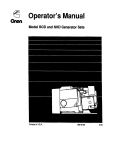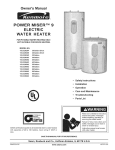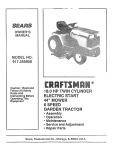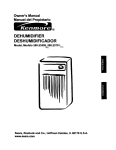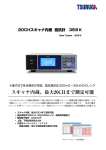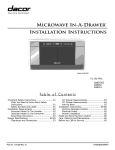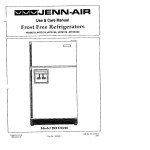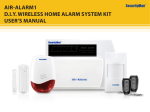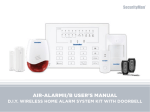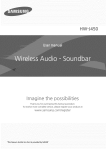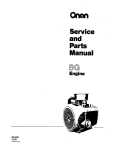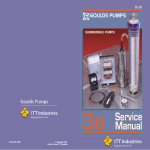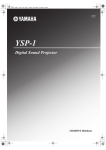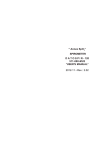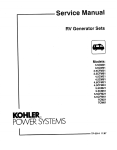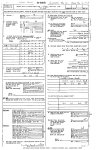Download Installation
Transcript
Installation Manual GenSets u 0 LISTED RV Electric Generating Set This manual must be given to the customer, along with the Operator’s Manual 965-0630 10-86 Printedin USA Safety Precautions This symbol warns of immediate hazards which will result in severe personal injury or death. Follow all state and local electrical codes. Have all electrical installations performed by a qualified licensed electrician. Do Not Smoke While Servicing Batteries 6 This symbol refers to a hazard or AW*R"'G i unsafepractice which can result in Severe personal injury or death. Batteries emit a highly-explosive gas that can be ignited by electrical arcing or by smoking. This symbol refers to a hazard or *'AUT'' j unsafe practice which can result in personal injury or product or property damage. Never sleep in the vehicle with the generator set running unless the vehicle is equipped with an operating carbon monoxide detector. Fuels,electrical equipment, batteries, exhaustgases and moving parts present potential hazards that could result in serious, personal injury.Take carein followingthese recommendedprocedures. Provide an adequate exhaust system to properly expel discharged gases. Check exhaust system regularly for leaks. Ensure that exhaust manifolds are secure and not warped. Do not work on this equipment when mentally or physically fatigued. Be sure the unit is well ventilated. - Use Extreme Caution Near Fuel. A constant potential explosive or fire hazard exists. Do not fill fuel tank near unit with engine running. Do not smoke or use open flame near the unit or the fuel tank. Be sure all fuel supplies have a positive shutoff valve. Use a non-metallic, non-conductive, flexible section of fuel line between the generator set and stationary fuel line in vehicle. LPG: The propane fuel supply lines MUST comply with all requirementsofNFPA501CSection3-5.paragraphs1.1 and 1.2 as well as Canadian Gas Association Bulletin 6149.2-78. The installer must review and comply with all applicable codes regarding fuel tanks, supply lines.and pressure testing complete system for leaksafter installationis completeand PRIORto initial operation of the generator set Have a fire extinguisher nearby. Be sure extinguisher is properly maintained and be familiar with its proper use. Extinguishers rated ABC by the NFPA are appropriate for all applications. Consult the local fire department for the correct type of extinguisher for various applications. Guard Against Electric Shock Remove electric power before removing protective shields or touching electrical equipment Use rubber insulative mats placed on dry wood platfqrms over floors that are metal or concrete when around electrical equipment Do not wear damp clothing (particularly wet shoes) or allow skin surfaces to be damp when handling electrical equipment Jewelry is agood conductorof electricity andshould be removed when working on electrical equipment DO NOT CONNECT GENERATOR SET DIRECTLY TO ANY BUlLDlNG ELECTRICALSYSTEM.Hazardoe voltages can flow from thegenerator set intotheutilityiine.Thiscreates a potential for electrocution or property damage. Connect onlythrough an approved device and after building main switch is open. Consult an electrician in regard to emergency power use. Use extreme caution when working on electrical components. High voltages cause injury or death. rr 4 - Exhaust Gases Are Toxic *- Keep the Unit and Surrounding Area Clean Remove all oil deposits. Remove all unnecessarygrease and oil from the unit. Accumula:ed grease and oil can causs overheating and subsequent engine damage and may present a potential fire hazard. When cleaning generator set. provide cover or other protection so that cleaning and rinse water, and other contaminantsare not allowed into the generator. air cleaner, control box, fuel solenoid, or electrical connec:ors. Generator set operation and internal components can be adversely affected. Do NOT clean the generator set while unit is operating. This can result in personal injury or product or property damage. Do NOT use high pressure air. water, or steam for cleaning generator set and compartment Dirt and other foreign matter can be forced into generator, engine and control housings. Generator set operation and internal components can be adversely aff9cted. Do NOT use high strength solvents. They can damage electrical connectors. Do NOTstoreanything in the generator compartmentsuch as oil or gas cans, oily rags, chains, wooden blocks portable propane cylinders, etc. A fire could result or the generator set operation [cooling, noise and vibration) may be adversely affected. Keep the compartment floor clean and dry. Protect Against Moving Parts Avoid moving parts of the unit Loose jackets, shirts or sleeves should not be permitted because of the danger of becoming caught in moving parts. , Makesure all nuts and boltsaresecure. Keep power shieldsand guards in position. If adjustments must be made while the unit is running, use extreme caution around hot manifo!ds. moving parts, etc. General Do not work on this equipment when mentally or physically fatigued, or after consuming any alcohol or drug that makes the operation of equipment unsafe. Redistribution or publication of this document, RV-G.LP-4 by any means, is strictly prohibited. e Table of Contents SAFETY PRECAUTIONS ................................ Inside Front Cover INTRODUCTION 2 GENERAL SPECIFICATIONS ........................................... 4 MOUNTING ............................................................ 5 Conventional Compartment Mount ..................................... 5 Under-Floor Mount .................................................. 8 VENTILATION AND ACOUSTICS ....................................... 10 10 Ventilation Acoustics .......................................................... 11 EXHAUST SYSTEM ................................................... 13 ....................................................... ' ... ._ ......................................................... .. General ............................................................13 Muffler Recommendations ........................................... 13 Exhaust Installation Guidelines ....................................... 13 Tailpipe Recommendations .......................................... 13 FUEL SYSTEM ....................................................... 16 General ............................................................. 16 Gasoline Fuel System ............................................... 16 Propane (LPG)Fuel System .......................................... 17 ELECTRICAL CONNECTIONS .........................................19 AC Wiring .......................................................... 19 DC Wiring .......................................................... 23 INSTALLATION CHECKS AND START-UP .............................. 26 Pre-Start Checks ...................................................26 Initial Start-up Inspection ............................................ 26 Installation Review .................................................. 28 Redistribution or publication of this document, by any means, is strictly prohibited. 1 Introduction Each RV generator set must be installed properly if it is to operate reliably,quietly,and most importantly - safely. Therefore, read the entire manual and housing/exhaust .kit instructions before starting the installation. This manual details installation procedures for the Onan BGE and BGELgeneratorsets. For operation and maintenance procedures, refer to the Operator’s Manual . * which accompanies each unit. The following list of installation codes and safe., recommendationspertains to the installation and operation of this RV generator set. The address of each agency is listed so that you can obtain a copy for your own use. I INSTALLATION CODES AND SAFETY RECOMMENDATIONS Listed and certified,this generator set meets or exceeds all requirements of the National Electrical Code, Article 551 (NFPA 70) as well as ANSI/RVIA Standard EGS-1. UL Standard 1248, and CSA Bulletin 946. Recreational vehicle installationsMUST comply with these specifications as well as ANSI 119.2, Standard for Recreational Vehicles. The recreational vehicle manufacturer and generator set installer MUST also comply with any local codes such as California Administrative Code Title 25, which pertains to the generator set installation. 1. ANSI-Al19.2 ANSI/RVIA-EGS-1 UL listing and CSA certification applies to 60 Hz models only. Requirements fo be considered prior to the installation are listed below. Each is covered in the following text or associated kit instructions. 0 0 0 0 0 0 0 0 ‘ Level and supportive mounting surface. Adequate cooling air. Discharge of circulated air. Discharge of exhaust gases. Electrical connections. Fuel installation. Accessibility for maintenance and service. Noise levels. Recreational Veh. Industry Assoc. 14650 Lee Road Chantilla VA 22021 2. NFPA 70 (N.E.C.) NFPA-501C National Fire Protection Assoc. 470 Atlantic Ave. Boston MA 02210 3. CSA Electrical Bulletin #946 Canadian Standards Assoc. - Housing & Const. Materials Section 178 Rexdale Blvd. Rexdale Ont. Canada M9W 1R 3 4. UL Standard 1248 Underwriters Lab Inc. 333 Pfingsten Road Northbrook IL 60062 5. California State of California Documents Section P.O.Box 1015 North Highlands CA 95660 Administrative Code - Title 25 Chapter 3 IAWARNINGI Incorrect installation, service, or replacement of parts can result in severe personal injury and/or equipment damage. Service personnel must be qualified to perform electrical and mechanical component installation. 2 Redistribution or publication of this document, by any means, is strictly prohibited. i BGE GOVERNOR ADJUSTMENTS SPARK ' . .* ._ SUMMER/WINTER ADJUSTMENT CARGURETOR ADJUSTMENTS FUEL PUMP INLET AC CIRCUIT BREAKERS REMOTESTART CABLE CONNECTION LOCATION O P ~ O N A L SPARK PLUG BGEL VAPORIZER \\ ADJUSTMENTS AC CIRCUIT BREAKER FUEL FILTER AND SOLENOIDASSEMBLY NEGATIVE(-) BA'K CABLECONNECTl TO PLATE LOCATIONOPTIONAL . POSITIVE(+) BATTERY CABLECONNECTION REMOTESTART CABLE CONNECTION M-1604-1 FIGURE 1. BGE AND BGEL GENERATOR SETS 3 Redistribution or publication of this document, by any means, is strictly prohibited. General Specifications ' .- ENGINE Onan opposed2-cylinder, 4-cycle,air-cooled,gasoline-fueled forthe BGE model and propane-fueled for the BGEL model. Remote start, negative ground, 12-volt, automotive-type starter. GENERATOR Onan-built, four-pole,revolving field, permanently aligned to engine. Frequency ....................... - 5 0 Hz.......................... 60 Hz 'Watts.. .......................... .3500 ............................ 4000 Volts.. .................... .11.0/220 or 1201240.. .................... 120 Amps.. .................. .31.8/15.9 or 29.2114.6.. .................. .33.3 Phase .............................. 10............................. .10 CONTROL Front-mounted control features fixed battery charger and remote start capability. . GENERATOR SET Dimensions* .. Height .............. :. ................................ 14.0 in. (356 mm) Length.. .............................................. 25.0 in. (635 mm) Width.. ............................................... 18.8 in. (478 mm) Weight 60 Hz. ................................................... SO Hz.. .................................................. Air Requirements: 60 Hz ......................................... 50 Hz ......................................... 218 Ib (99 kg) 228 Ib (104 kg) -480ft3/min (1 3.6 m3/min) .400 ft3/min (11.3 m3/min) Fuel Inlet Connection BGE ...1 ............................................. 1/4 in. barb fitting BGEL.. .................................................. - 1/4in. NPTF Battery Voltage .................................................. .12 volts Recommended Battery Capacity'. ................ .360 cold cranking amperes Cranking Current ............................................. 100 amperes rlmin at: 60 Hertz .......................................................... 7800 50 Hertz ......................................................... 1500 *Under-Floor mount generator set with compartmenthousing has slightly larger dimensions. See Mounting section. Redistribution or publication of this document, by any means, is strictly prohibited. c .. . Mounting 2. Line the compartment walls with 26-gauge galvanized steel or a materialof comparable strength, durability and fire resistance (see NFPA 70, NEC and California Title 25 for complete details). 3. Construct the compartmentfloor in a manner so as to prevent oil, fuel or water accumulation. Compartment drainage can be accomplished by 1/2 inch (13 mm) diameter holes as shown on the compartmentfloor drawings, Figure 3. Read the entire manual and housing/exhaust kit instructions before installing the generator set The generator set is designed for two very different types of installations; conventional compartment mount installa: tions and under-floor mount installations. Choose the appropriate section describing each and carefully follow the instructions given. CONVENTIONAL COMPARTMENT MOUNT Fire presents the hazard of * jaWAR"G1 severe personal injury or death. To prevent a fire hazard, do not position the muif/er directly below a drain hole. In a conventional installation the generator set is actually installed on a framework that is part of the recreational vehicle (RV).This framework must be constructed in accordance with the safety-approved specifications contained in the following Compartment Construction section.. Do NOT use absorbent sound proofing material on compartment floor. The floor should have minimal openings to reduce sound level. 4. Equip base with an oil drain hole to the outside of Unless generator set is to be removedfrom underneath, plan the location for an access opening to be large enough to permit set removal. Allow additional clearance for easy access to the oil fill, drain, filter and oil dipstick as well as the air cleaner element, circuit breaker, governor adjustments,carburetor adjustments, Start/Stop switch, and DC fuse. The locations of each are shown in Figure 1. compartment. Do not mount the muffler below the oil drain valve. Exhaust gases present the hazard of severe personal injury or death. Make the comparfment walls vapor-tight to the interior of the vehicle toprevent exhaust fumes from entering ihe vehicle coach. Designthe compartment large enoughfor the generator set, with 0.6 inch (15 mm) minimum clearance between the generator set and compartment walls and ceiling (and acoustical material, if used). See Figures 2 and 3. 5. Secure the generator set mounting plate to support frame using 318-1 E UNC, grade 5 screws. The back two mounting holes are supplied with weld nuts to facilitate installing screws. The front two holes can be secured with 318-16 screws, lockwashers and nuts. The front holes are square to allow use of 3/8-16 cage nuts if desired. See Figure 3. Compartment Construction 1-1 Road vibrations can cause component damage to generator set if unit mounting plate is not fastened securely to vehicle compartment, Use screws of sufficient length to allow a minimum of 1-1f2 threads to extend through nut to ensure maximum holding power. 1. Install the generator set in its own compartment. Separatethecompartmentareafrom the living quarters and any fuelsupply (gasoline or propane)with a vapor-tight wall. See Figures 2 and 3 for minimum clearances and compartment size. 5 Redistribution or publication of this document, by any means, is strictly prohibited. ;E,y m: :& OIL FILTER REMOVAL *-AIR FILTER - FUEL INLET 114 INCH OIL DRAIN VALVE FOL .62 1.0. HOSE I 1317.0 1 DISCHARGE \ “L FUEL INLET 0 25 nos€ ¶4RB ALT FUEL PUMP ( OPTIONAL EXHAUST OUTLET NOTES: 1. DIMENSIONING INCLUDES 0.6 INCH (15 mm) MINIMUM CLEARANCE REQUIRED BEMlEENSETANDlNSUIATlONORCOMPARTMENTWALLS. 2. IF COMPARTMENTIS LARGERTHANMINIMUM SHOWN. ALLOW EXTRA SPACE AT OIL FILL SIDE AND EQUALLY ON BOTH ENDS. 3. ALLOW MINIMUM OF 0.6 INCH (15 mm) CLEARANCEBETWEENTOP OF SET AND INSULATlON OR COMPARTMENT CEILING. MINIMUM HEIGHT14.60 INCHES. 4. WEIGHT - 218 LBS. (99 kg). 50 Hz-228 Lb1104 kg. 5. DIMENSIONSIN ( ) IN MILLIMETRES. VIEW A-A .75 INCHCONDUITWITH AC. PIGTAILS36.0 INCHES (0.92 m) LONG 500-2126 FIGURE 2. BGElBGEL COMPARTMENT MOUNT OUTLINE (BGE SHOWN) 6 Redistribution or publication of this document, by any means, is strictly prohibited. I s o sa. HOLE X 19.75 (501.6) (127)2 PLACES NOTES. 1. DIMENSIONS INCLUDE 0.6 INCH (15 mm) CUT-OUT FOR COOLING AIR DISCHARGE . CONVENTIONALCOMPARTMENTMOUNT BGE-BGEL WlTH END-MOUNTEDMUFFLER MINIMUM CLEARANCE REQUIRED BETWEENSETANDiNSUWTlONOR COMPARTMENTWALLS. 2. IF COMPARTMENTISLARGERMAN MINIMUM SHOWN. ALLOW EXTM SPACE AT OIL FILL SIDES AND EQUALLY ON BOTH ENDS. 3. ALLOW MINIMUM OF 0.6 INCH (15 mm) CLEARANCEBETWEENTOP OF SETAND INSULATION OR COMPASTMENT CEILING. MlNiMUMHEIGHT- 14.60 INCHES(371 mm). 4. DIMEF.!SIDNS ( ] A R E IN MILUMETRES. 5. SWARE HOLES (5.5il/127) ARE SUITABLE FOR USE OF 3 8 IWCHCASE MU. .JOBDRAIN HOLE (127)2 PLACES FIGURE 3. COMPARTMENT FLOOR PLAN . 7 Redistribution or publication of this document, by any means, is strictly prohibited. UNDER-FLOOR MOUNT For an under-floor mount installation,the generator set is mounted in a housing belowthe floor and outsidethe coach of the recreational vehicle. This housing assembly should be as supplied or approved by Onan, and must be installed in accordance with safety approved specifications. Review the following text for general applicationinformation,and reviewthe proper housing/ exhaust kit instructions for further specifics regarding under-floor mount installations. .- The vehicle construction must be able to support the weight of the generator set (see General Specifications). It is the vehicle manufacturer’s and the installer’s responsibilityto provideand assure a structurallysound support frame, by using tubing, angle brackets, or with steel reinforced plywood or other composition board. Reinforcementof plywoodor particle boardcan be with 3 inch (76 mm) or larger washers or a full metal plate. General Generator Set Location: When choosing a location for mountingthe under-floormount generatorset, consider the following not only for mounting, but for protectionof the generator set as well. Figure 4 shows the most common mounting areas of a RV generator set in a recreationalvehicle. If the generator set is mounted on the curb side, location l or 2, protect the generator end of the generator setfrom road splash and debris. If mounted on the driver’s side, location 3 or 4, protect the engine end of the generator. (Installationshould be verified bya road test in mud and slush). Refer to shaded areas of Figure 4. Leave an area between the generator set and the recreational vehicle skirt for an air inlet if it is not subjected to road splash. See V€NTlLATlON for more detailed information. Air inlet openings to the generator set compartment must not allow dirt, rock, water, or slush to directly hit the generator set. Oust and salt entrance into the compartment must be minimized. Pay special attention to protection of the generator, control, choke, and governor areas. Baffi&might be required to protect certain areas. Access Opening: Provide an access opening og the side of the recreational vehicle for the generator set. Make it largeenoughto allow for checking or adding oil, for adjusting governor and carburetor, and for accessto the control panel and AC circuit breaker. The opening should also provide accessfor oil and air filter replacement so that the generator set does not have to be lowered for these procedures. See Figure 1 for locations. Y Mounting Clearance: If the compartment door does not openthe full width of the generatorset andto the bottom of the vehicle skirt, provide 2 inches (51 mm) minimum betweenthe tray andthe skirt of the recreationalvehicle. This distance allows loweringthe generator set without hitting the vehicle skirt. Figure 5 shows basic dimensions of the under-floor mount generator set. Housing Assembly The recreationalvehicle must be adapted forthe underfloor housing.The constructionof the vehicle mustsupport the weight of the generator set. It is the vehicle manufacturer‘s responsibility to provide a structurally sound frame and carriage bolts or equal to attach the housing kit. failure to meet Onan approval for modifications of housing kits or for non-Onan kit housing installations may void intent of U L K S A approval. Liability for damage or injury and warranty expenses becomes the responsibility of the person making the modifications. Use template supplied with housing kit to insure that panels are installed square to each other. Failure to mount panelssquare may result in spark plug breakage. Review the exhaust system kit installation instructions and componentparts. Plan clearancesfor movement or removal of exhaust components when generator set is lowered for inspection/maintenancepurposes. ~ REFER TO EXHAUST KIT INSTRUCTIONS INSTRUCTIONS FIGURE 4. 8 COMMON MOUNTING AREAS OF GENERATOR s Redistribution or publication of this document, by any means, is strictly prohibited. . r OIL FILL AM0 CHECK 8 NOTES ALT NELPUMP 1. DIMENSIONS INCLUDE 0.E INCH (15 mm) MIN REQUIRED CLEAWNSE BETWEEN SET AND INSULATION OR COMPARTMENT WALLS. 2. IF COMPARTMENT IS LARGER THAN MIN SHOWN. ALLOW !EXTRA SPACE AT OIL FILL SIDE AND EQUALLY ON BOTH ENDS. 3. WEIGHT 213 LB (93kg) 50 Hz-228 Lb1104 kg. 4. DIMENSIONS IN ( ) ARE IN mm. NEL $NET WE 8410 m 2: .75 INCH CONDUIT WITH AC. PIGTAILS 36.0 INCHES A.C. CIRCUIT BREAKERS \' RU.a 159LOlYIN CLCkUNCC rOR UIT 5WW 'w . VIEW A-A 500-2135 FIGURE 5. UNDER-FLOOR MOUNT BGEIBGEL (BGE SHOWN) 9 Redistribution or publication of this document, by any means, is strictly prohibited. Ventilation and Acoustics VENTILATION When planningthe air inlettothegeneratorset,allowfor airflow restrictions caused by grilles and duct work. Some expanded metal grilles provide only 60 percent free air inletarea per squarefoot. Eventhe most efficient grille only provides about 90 percentfree inlet area per square foot The free inlet area of the material can be obtained from the material supplier. Multiply the grille area times the percent of free area of the grill to obtain the free inlet area. The most important factors of ventilation for an RV aircooled generator set are sufficient incoming air (for combustion and cooling) and adequate exhausting of heated air. All Onan generatorsets for recreational vehicles use Vacu-Flo@cooling. Acentrifugal fan in a scroll housing on the engine (Figure 6 ) draws air from the generator end of the compartment,through the generator (generator also has a cooling fan), and over the cooling surfaces of the engine, then discharges the heated air out through the VacuFloe discharge opening. I .. .. Inlet air ducting should provide a directfree-airflow path to generator set, with minimal bends;and materials used should be smooth and non-restrictiveto airflow. Make sure nothing obstructs or restricts discharged airflow and that recirculationof air is minimal. A dust or noise deflector if added must be a minimum of 6 inches (150 mm) below the generator set and open on three sides. Air inlet openingsshould be locatedas high as possible to allow for convection cooling of heated air from the generator set compartmentafter unit shutdown. Otherwise, hard starting might result due to vapor locking (gasolinefuel), hot combustion air, etc. Exhaust gas presenfs the hazard of (BWARNINGI severe personal injury or death. Since discharged cooling air can contain some exhaust gas, never use discharged cooling air for heating. - Fuel or fuel leakage presents the IBWAR”G1 hazardoffireor explosion which can cause severe personal injury or death. The ventilation system should provide a constant flow o f air to expel any accumulation of fuel vapor. Compartments must be vapor-tight to the vehicle interior to keep fumes fromentering the vehicle. The free air inlet area is critical for proper generator set operation and cooling. A minimum free air inlet area of 85 in2 (548 cm2)with no restrictions is required. Reference: the generator set air discharge rate is 480 ft3/min (1 3.6 m3/min). To obtain the 85 in2(548 cm2) free air inlet area, Onan recommendsbringing in coolingairthtough the recreational vehicle skirt. This can be accomplished by using the access door, ducting intothe generator end from the side wall, or using the horizontal area between the recreational vehicle skirt and the generator set along with the vertical area (if road splash is not a problem see the MOUNTINGsection).SeeFigure7for reference to these areas. If the skirt of the vehicle does not extend to or belowthe top of the generator set drip tray, provide an extension. , You can bring air from under the coach for cooling. However, run tests while the recreationalvehicle is both parked and while the vehicle is moving at highway speeds to ensure proper cooling with this method. A temperature rise of 8°F (4.4OC) between the outside ambient and air in the top openings of the generator housing is acceptable. FIGURE 6. VACU-FLO@COOLING SYSTEM . . Redistribution or publication of this document, by any means, is strictly prohibited. 10 b I I Duct MINIMUMFREE AIRFLOW TO GENERATORSET COMPARTMENT (MAY BE CUMULATIVE): 85 IN2 (548cmt) Skirt 1 R V Floor7 Air In ,Skirt AIR INLET BETWEEN RV SKIRT AND GENERATOR SET Air Out ACCESS DOORAIR INLET DUCT FROM SIDEWALL TO GENERATOR FIGURE 7. AIR INLET ALTERNATIVES FOR UNDER-FLOOR , MOUNT GENERATOR SET. ACOUSTICS Rather than using one single material, a combination of materials can reduce noise considerably. For instance, a sheet of lead or viscoelastic material and a layer of acoustical materials is more effectivethan either alone. The Onan housing kit for the under-floor mountgenerator set contains acoustical material to minimize noise. Additional insulation is not necessary. If, however, you are constructing your own compartment or housing, use the following guidelines. To reduce line of sight noise, a sound panel (baffle) should be added behindtheair inlet. The panel must be spaced to allow for minimumfree air inlet of 85 in2 (548 cm2). For the conventional compartment mount, if compartment penetrates floor, be sure all joints and comers of the compartment are vapor-tight to the interior. Lining the compartment is less effective if openings, cracks, doors, and joints are not sealed. Also, seal compartment door edge to eliminate noise leaks around the door perimeter. Referto Figure8 to aid your generator set compartment design and noise reduction plans. Size ducting to ensure that minimum free airflow of 85 in2(548 em*) is still attained after acoustical material is added. High temperatures in the compartl3iE@@I ment can present the hazard fire which can resulf in severe personal injury or death. To Cover the sound reflectivesurfaces, back, top and sides (not compartment base) with fiberglass or other selfextinguishing acoustical material. Acoustical material and adhesive should be rated for use at 2OOOF (90°C) minimum. of meet UL,ANSl and CSA femperafurerise requirements for recreational vehicles, insulafionmust not reduce fhe 0.6 inch (15 mm) clearance specified. 11 Redistribution or publication of this document, by any means, is strictly prohibited. 12 Redistribution or publication of this document, by any means, is strictly prohibited. Exhaust System GENERAL Excessive exhaust back pressure can cause engine damage. If tai/pipe deflector is used, make sure it is large enougb to prevent back pressure. Plan each individual exhaust system carefully.A proper installation is not only vapor-tight, but usually quieter and safer too. Be sure to check all applicable standards, local codes and regulations. .. .- Water vapor can cause engine dam/ exhaust - to the vehicle age. Do not connectthe generator set exhaust .system since water Refer to the following text for recommendations to follow when installing the exhaust system. Then refer to the installation instructions supplied with the exhaust system kit for specific mounting procedures.%ee Figures 9 and 10 for exhaust kit options. vapor from one engine can damage the other. MUFFLER RECOMMENDATIONS Onan supplied mufflerisparkarresters are forest service approved and meet code requirements. (Failureto provide and maintain a sparkarrestercan be in violation of the law.) Use only ONAN UL/CSA tested mufflers. TAILPIPE RECOMMENDATIONS An exhaust tailpipe is NOT supplied because of variation in length requirements between motor home manufacturers.After muffler is installed and prior to installing exhaust tailpipe, refer to the following recommendations for additional tips and safety considerations. Liability for damage or injury and warranty expenses dueto use of unapproved mufflers or installation modifications becomes the responsibilityof the person installing substitute muffler or performing the modifications. Contact an Onan distributor for approved exhaust system parts and installation instructions. Use 1-318 inch I.D. 18 gauge rigid steel tubing for tailpipe. I Exhaust gas presents the hazard oi ~AWARNING severe personal injury or death. Do EXHAUST INSTALLATION GUlDELlNES The exhaustsystem must be no closerthan 3 inches (76 mm) from combustible material (wood, felt, cotton, organic fibers, etc.), or be so located, insulated or shielded, that it does not raise the temperature of any combustiblematerial more than 1 1 7 O F (65OC)abovethe ambient air inlet temperature. not use flexible exhaust tailpipe since it can leak or break due to road shock or vibration. Do not terminate exhaust sysiem under the vehicle. Direct exhaust gases away from any window, door, or compartment openings. Do not operate the generator set without an exhaust tailpipe. Use U-bolt type automotive muffler clamps marked 1318 and double rubber, U-shaped shock mounted hangers for supporting the exhaust system. If tailpipe extends beyond 1-1/2feet (0.46 m) from muffler. attach The exhaust system must extend a minimum 1 inch (25 mm) beyond the perimeter ofthe vehicle. If the generator set tailpipe is on the same side of the coach as the compartment. try to terminate the tailpipe aft of the generator set air intake to reduce the possibility of exhaust recirculation, by directing the exhaust down and to the rear. an automotive tailpipe hanger for additional support The exhaust system should be supported at or near the perimeter of the vehicle to prevent the pipe from being damaged and pushed up under the skirt. Exhaust gas presents the hazard of severe personal injury or death. Use only Onan specified exhaust equipment with generator set and support the system per kit instructions. Angular mounting of muifier and tailpipe hanger brackets can result in exhaust system damage. Properly mounted hanger brackets wili absorb much road shock vibration and prolong the usefulness of exhaust system components. Mount muffler and iailpipe hanger brackets directly above the componentsupported,not at an angle. Do not twist the rubber sections of any hangers. :igCAUT'oN Exhaust gas presents the hazard of iAWARNiNG 1 severe personal inibry or death. Do not terminate exhaust gas under vehicle. Do not terminate exhaust system directly under any vent, window, or opening which can be opened and which is not pennanenilysealed from the vehicle living space. Keep all openings closed when the generator set is running. 13 Redistribution or publication of this document, by any means, is strictly prohibited. . HANGER BRACKET (3 FOOTll METRE FROM DOWNPIPE. OR AT PERIMETER OF VEHICLB EXS1147 .. EXHAUST ACCESSORY KIT 542-0471 SHOWN us-1146 fIGURE 9. EXHAUST SYSTEM K K EXAMPLES FOR CONVENTIONAL COMPARTMENT MOUNT GENERATOR SET 14 Redistribution or publication of this document, by any means, is strictly prohibited. .. EXHAUST ACCESSORY KIT 542-0482 SHOWN TAILPIPE NOT FURNISHED BY ONAN EXHAUST ACCESSORY KIT 542-0469 SHOWN EXHAUST ACCESSORY KIT 542-0470 SHOWN Exs-1149 %-- TAILPIPE NOT FURNISHED BY ONAN FIGURE 10. EXHAUST SYSTEM KIT EXAMPLES FOR UNDER-FLOOR MOUNT 15 Redistribution or publication of this document, by any means, is strictly prohibited. Fuel System GENERAL This installation manual covers gasoline and LPG (liquid-propane gas) fuel systems. The Onan BGE model is gasoline-fueled, and the Onan BGEL model is liquid LPG fueled. Separate procedures are given for each. Half Load Full Load 60 Hz 0-4 gallhr (1.5 Ilhr) 0.6 gal/hr (2.3 I/hr) 0.8 gallhr (3.0 Ilhr) 50 Hz 0.35 gal/hr (1.3Ilhr) 0.53 gallhr (2.0Ilhr) * 0.73 gal/hr (2.8Ilhr) Fuel Line Installation Recreational vehicle fuel systems are designed to operate in a critical pressure range. It is very important during the installation of the generator set that the vehicle fuel supply design NOT be altered. The fuel fill tube, fill limiter vent, vapor canister, vapor lines and gas fill cap should never be changed, removed or replaced without PRIOR approval from the vehicle manufacturer. Check the filler cap to ensure that the pressure vacuum relief valve is functioning properly. Replace if required. . Fuel System Provisions Generator set installationsmay be designed to sharethe vehicle fuel supply tank with the vehicle engine. AI1 connections to the vehicle fuel tank must be done in accordance with chassis (vehicle) manufacturer's detailed installation instructions. See Fuel Line Installation. . No Load b . Fuel presents the hazard of fire or explosion which can result in severe personal injury or death. Do not smoke or allow any ignition sources in the installation area. Keep a type ABC fire extinguisher nearby. The ventilation system of the installation area mustprovidea constant flow of air to expelany accumulation of fuel vapor while the vehicle is in transit. Compartments must be vapor tight to fhe vehicle interior to prevent any fumes from entering the vehicle interior. GASOLINE FUEL SYSTEM Model . If separate connection is not supplied for the generator, addasecondfuel pickup inthetank.This pickupshould not extend below the bottom 1/4 of tank so the vehicle can still be run, after generator runs out of fuel. Do NOTtee off the vehiclefuel line, doing so may cause poor operation of the generator or the vehicle. Consult with vehicle manufacturer forfurther specifics regarding ashared fuelsupply. Unauthorized fuel system modifications could result in dangerous operating conditions. The generator set includes a fuel shut-off valve as a safety feature and is an integral part of the fuel pump. Should the vehicle fuel tank become pressurized, the positive fuel shut-off prevents flooding of the generator set when the set is not operating. a A C A ~ O N Connecfingfhe generator set fuelline with a fee to the main fuel.line can Forlhe possibility of contaminatedfuel, Onanrecommendsan in-line luel filter. resun in fhe generafor set starving for fuel when ihe vehicle is operated at highway speeds. The generafor Recommended Fuel Use clean, fresh, unleaded or regular grade gasoline. Using unleaded gasoline results in extended periods between service, longer spark plug life, and reduced carbon.clean-out maintenance. If regular gasoline is used, lead deposits must be removed from the cylinder heads as required to 'alleviate engine power loss. Unleaded gasolinemay be safely used after lead deposits have been removed. . . set fuelpump has neither the capacity nor the power to overcomefhe draw of the vehicleenginefuelpump. Use a separafe fuel line forthe generafor set. I-[ Gasolinepresentsthe hazardof explo- sion orfire which can resulf in severe personal injury or death. Do not connect the generator set fuel line to the pressurized part of the vehicle fuel system. Flooding of the generator set engineand compartmenf can occur, resulfing in a fire hazard. Do not alternate between leaded k&%! @ l (regular) and unleaded gasoline. Lead deposits can cause engine damage if not tnstall an approved, flexible non-metallic (nonconductive)and non-organic fuel line between the vehickfuel system and the generator set to absorb vibration. Onan recommends using a seamless steel tubing and flared connections for long runs between the fuel tank and the flexible connector to the generator set. removed before using unleaded gasoline. Fuel Consumption It should be noted that under varying electrical loads, fuel consumption of engines for recreational vehicle generator sets varies accordingly. Run fuel lines at the same height as the top level of tank to a point as close to the engine as possible. This redu- cesthedangeroffuelsiphoningoutofthetankiftheline should break. 16 Redistribution or publication of this document, by any means, is strictly prohibited. . When installing the fuel lines, keep the following in Keep fuel lines awayfrom hot engine or exhaust areas. This reduces chance of vaporlock. Install lines so that mind: they are accessible and protected from damage. Use metal straps without sharp edges to secure them. 1. Install all propane fuel lines so they are accessible, yet protected from damage. Flexible line must be long enough to allow for set movement in order to prevent binding, stretching or breaking. + ' ..- PROPANE (LPG) FUEL SYSTEM (60 Hz Only) Fuel System Provisions Onan liquid LPG generatorsets contain afiltercartridge and magnet in the fuel solenoid valve to protect the solenoid valve and regulator valves from dirt and contaminants. The solenoid valve and filter is shown in Figure 11. Figure 12 shows the flow diagram for the liquid LPG fuel system componentsused on thegenerator set Generator set operation using liquid LPG is very sensitive to altitude,temperature,and BTU contentof the gas. Variation in any one of these factors directly affectsthe performance of the generatorset. Because of this, minor adjustments might be required after the installation, refer to Generator Set ServiceManual if adjustmentsare required. . , Recommended Fuel Use clean, fresh commercial propane or HD-5 grade liquid propane gas in a mixture of at least 90 percent propane. Propane fuelsotherthan HD-5 gradecan contain more than 2.5 percent butane and can result in poor fuel vaporization and poor engine starting in low ambient temperatures (below 32°F or OOC). FUEL FILTER BODY FIGURE 11. FUEL SOLENOlO VALVE AND FILTER 2. Use metal strapswithoutsharpedgesto securefuel lines. 3. Keep fuel lines away from hot engine or exhaust areas. 4. Do NOT run fuel lines in conjunction with electrical wiring. Fuel Consumption It should be noted that under varying electrical loads, fuel consumption of engines for recreational vehicle generator set varies accordingly. Average fuel consumption at various loads is shown in the table below. Most propane (LPG) liquid withdrawal generator set installations are designed to sharethe vehicle propane fuel supplytank(s). The vehicle propanefuel supply tank MUST have a dip tube to ensure liquid withdrawal. LPG FUEL CONSUMPTION No &ad Half Load Full Load 0.5 gal/hr (1.9 I/hr) 0.8 gal/hr (3.0 Vhr) 1.3 gal/hr (4.0 I/hr) An excess flow valve MUST be mounted internal to the propane fuel supplytank(s)per NFPA 501C, Paragraph 3-4.4. This excess flow valve and propane fuel lines MUST be sized so the excessflowvalve will close with a Propane Fuel Lines and Supply Tank . The installer must review all codes that apply to the particular installation. Paragraph 3-5.1 (GasPiping Systems) of NFPA Pamphlet 501C deals specifically with propanefuel linesbutdoesnotnecessadycoverallapplicable codes and regulations. You can obtain this pamphlet from the address listed in the beginning of this manual. completely severed (broken) propane fuel line. For operation at the lowest ambient temperature, a valve rated at 2.6 gallons per hour (9.9 Vhr) flow rate and 6.5 pounds per square inch (45 kPa) differentialpressure is recommended. Consultthe Natural LP Gas Association for the limitations of excess flow valves. 17 Redistribution or publication of this document, by any means, is strictly prohibited. Testing Fuel System for Leaks Install an approved flexible non-metallic (nonconductive)and non-organic fuel line betweenthevehicle fuel system and the generator set to absorb vibration. Onan recommends using a seamless steel tubing and flared connection for long runs between the fuel tank and the flexible connector to the generator set. The completed propane fuel system installation MUST be checked and tested for leaks before the generator set is operated. The fuel solenoid MUST be energized from a separate 12 volt DC source before testing the fue system for leaks. The test MUST conformto procedure: listed in NFPA-58, Paragraph318,or UL recommended test procedure as follows: A manual shut-0%valve MUST be mounted on the propane fuel supply tank. This supply tank valve MUST be fully open when operating the generator set to ensure the excess flow valve will close with a severed (broken) propane fuel line. After assembly and prior lo initial operation, all iuel system connections, hose, valves, regulators,andfittings must be testedand proven free of any leaks using a soap and water or equivalent solution while the system is under a gas or air pressure of not less than 90 pounds per square inch (620 kPa). .-A hydrostatic pressure relief valve MUST be installed between the propane fuel supply tank manual shut-off valve and the propane fuel solenoid valve and filter assembly. Other approved methods of detecting leaks may be used if appropriate. Test shall NOT be made with a flame. Liquid LPG fuel presents fhe hazard Ei S Si E I of explosion or fire which can result in severe personal injury or deafh. Do not smoke or This relief valve protects the propane fuel line from pressurebuildup if boththe supply tank manual shut-off valve and the fuel solenoid valve are closed at the same time. ' allow any ignition sources in the installation area. C. CARBURETOR *l/enluri lype with bolh a "Main"andI 'Idle!et adjustments. when carburetor provides suclion Io fuel outlet. " w . a l d o t I u r V ~ ~ ) Mu3 confonnto ASME or dol and CTC slandards. (Working pressure Must Close with Completeline Breakage. Consult National LP Gas Associalion Publication 113-78 For Limitations. VblQZ FIGURE 12 FLOW DIAGRAM OF UQUIDLPG FUEL SYSTEM 18 Redistribution or publication of this document, by any means, is strictly prohibited. . .. Electrical Connections All wiring must meet applicable local electrical codes. Accordingly, have a qualified electrician install and & * _ I To reposition 90” conduit fitting, loosen locking nut inspect the wiring. (toothed ring), turn fitting counterclockwiseto desired location, and retighten locking nut Mount switches and controls securely to prevent damage from vibration and road shocks. All switches must be vibration-proof to prevent accidental opening or closing while the vehicle is in motion. Run conduit in such a way as not to interfere with the movement of the set. This is especially pertinent to the under-floor installationin which the set must be free to move. _ AC WIRING Wiring Disconnect Method The feeder conductors from the set compartment must terminate in a properly sized double-pole, double-throw positive offswitching device before the vehicle distn‘bution panel, or connect to a generator set receptacle box This assures the outside power source cannot be connected simultaneously with the generator set Figures 13 and 14 illustrate two possible wiring connections. Figures 15 and 16 show generator set wiring diagrams and schematics. Wire Types The conductors of the generator set must have an ampere rating not less than 115 percent of the nameplate current rating of the generator. The Onansupplied AC feeder conductor insulation is rated at 125°C. Wires connectedto the Onan feeder conductors must meet this insulation rating, or must be of a larger wire size (see National Electrical Code, NFPA 70). Electrical shock can cause severe personal injury or death. Use only approved power supply assemblies. Never remove grounding pin from assemblies. Incorrect or no ground can cause the recreational vehicle to become electrically “hot”. Equip fhe recreational vehicle with adequate Ground-fault Circuit Protecfion devices fo meet the ffafional Electrical Code (fffPA 70,557-7 (C) and personal safety. Exhaust gas presents the hazard of severe personal injury or death. To prevent exhaust gas from entering vehicle interior, seal all openings made for conduit, wiring, etc. Seal wiring within conduit itself. 1-1 i*wARNlNGi Conduit Install generator load conductors supplied with the generator set in a flexible metallic conduit. Cut conduit to desired length, leaving extra wire as requiredfor the junction box (connecting wires must be appropriately sized and insulated for the specified current rating). Prepare ends of conduit to prevent sharp edges from cutting wire insulation. Gasolineand liquid LP G fuel present fhe hazard of fire or explosion which can result in severe personalinjury or death. Do not fie electrical wiring to fuel lines. I 1 aWARNING ! 19 Redistribution or publication of this document, by any means, is strictly prohibited. '. DOUBLEPOLE DOUBLETHROW SWITCHINGDEVICE *IMPORTANTI GROUND-FAULT CIRCUK INTERRUPTERS (GFCl's) ARE REQUIRED BY THE NATIONAL ELECTRICAL CODE (NFPA 70. 551-7(C) IN ALL EXTERNAL AND SOME INTERNAL OUTLETS. TO PROPERLY EQUIP YOUR RECREATIONAL VEHICLE WITH THESE PROTECTIONDEVICES.CONTACTYOURRV MANUFACTURERORDEALERFORRECOMMENDATIONS .. POWER SUPPLY CORD .. SC-1463 FIGURE 13. SWITCHING DEVICE WIRING FOR UTILITY POWER 30 AMP U VWlCLE AC DISTFIlBUTIONPANEL \ 30 AMP SET MOUNTEDBREAKER HACR BREAKER FOR AIR CONDITIONER *IMPORTANTI GROUND-FAULT ClRCUrr INTERRUPTERS (GFCl's) ARE REQUIRED BY THE NATIONAL ELECTRICAL CODE (NFPA 70. 551-7(C) IN ALL EXTERNAL AND SOME INTERNAL OUTLRS. TO PROPERLY EQUIP YOUR RECREATIONAL VEHICLE WITH THESE PROTECTION DMCESCONIACTYOURRV MANUFACTUREROR DEALW FOR UECOMMENDATIONS. MAIN t I POWER SUPPLYCORD I FIGURE 14. USING UTILITY POWER CORD FOR SWITCHING 20 Redistribution or publication of this document, by any means, is strictly prohibited. REMOTE PANELS DELUXE I, ADD JUMPER +v I STANnAun I WIRING DIAGRAM i A3 I I REMOTE I I I I I I I I I I I - 1 I I I I I1 I I I I I I I I I I I I I I I I -1 I I I I K5 1RELAY-USEOWiTHLffiONLY KI ISTART SOLENOID I E3 FUEL PUMPlOR FUELSOLENOIO E12 ISPARK PLUG CIRCUIT BREAKER (AC OUTPUT1 611-1174 (Rd) CI lCAPAClToR BTI I WdlERY 12V flGURE 15.60 Hi! GENERATOR SET WRING DIAGRAM/SCHEMATIC 21 Redistribution or publication of this document, by any means, is strictly prohibited. REMOTE PANELS DELUXE STANDARD .. W1.2 T2 TI U SZ SI R6 KS ‘CROUHKD Ac LEAD KI HI GI FI E3 E12 fB.2 CR4 CRS CI BTI e1 A3 611-1177 A2 AI JUMPER-WIRE TRANSFORMER IGN COIL IGN POINTS SWITCH- LOW OIL PRESSURE SWITCH-STMISTOP RESISTOR-BATTERY CHARGE RELAY-USE0WITH Lffi WLY STARTSOLEWD CHOKE GENERATOR FUSE FUEL PUMP/OR FUEL SOLENOID SPARKPWG WRWlT BREAKER (AC OUTPUT) BRIDGE RECTIFIER RECTIFIER -USED WITH LPG ONLY CAPACITOR E A T E R Y 12V STARTER STANDARD REMOTE CONTROL D U X € REYOTE CONTROL CONTROL ASSY _ I Redistribution or publication of this document, by any means, is strictly prohibited. , DC WIRING 1-5/16IN. Remote Switch Wiring The standard remote control includes a start-stop switch and indicator lamp. The deluxe control contains these items plus a running time meter and a battery condition meter. Install as follows: + * .. -Y(33.3;1n) 1. Select control location. Use Figures 17 and 18 as guides. Drillscrew holesand cut holeto accommodate remote switch in dash panel. 2. Following nationaland localelectricalcodesandusing #18 or larger insulated wires of predetermined length, connect remotecontrolto generatorset Referto Figure 19 for wiring connections. 3. Connect jumper betwezn terminal 5 and 6 on deluxe panel. 'v! flectrical induction can occur when DC wires are run with AC wires and can cause operational problems. M-1580 4. insert remote control in hole cutoutand secure with woodscrews supplied with switch. . FiGURE 17. CUTOUT FOR STANDARD CONTROL Exhaust gases present the 1 - or1 death. Seal allhazard of severe personalinjury holes to prevent entrance of 4-1.'81N exhaust gases in20 recreational vehicle interior. 1- Incorrect connections can darnage control, remote switch, and interconnecting wiring. Ensure that leads from remote switch connect with the corresponding terminals on generator set. 5. When wiring is complete, check for proper operation by starting and stopping set at the set control and from the remote control panel. M-1581 Battery charge rate ammeter, running time meter and generatinglamp should be operatingonly while the generator set is running. 6. If the set starts by itself or cannot stop, check for short-circuited remote control wiring. FIGURE 18. CUTOUT FOR DELUXE PANEL 23 Redistribution or publication of this document, by any means, is strictly prohibited. - I GENERATING LAMP (GLOWSWHEN SET IS RUNNING) - DELUXE PANEL NOTE: USE i a GAUGE OR LARGER WIRE FOR INSTALLING THE REMOTE START SWITCH. BATI'ERY CHARGE R METER BACK SIDE OF REMOTECONTROL SWITCH REMOTE CONNECTOR RATEAMMETER c- STANDARD PANEL GENERATING LAMP [GLOWS WHEN SET IS RUNNING1 SETTERMINAL REMOTE SWITCH TERMINAL FUNCTION 1 1 GROUND 2 3 2 STOP 6 WIRE COLOR CODE 3 START BLACK BROWN YELLOW 6 LAMP AND RUNNING TIME M n E R RED BATlERY CHARGE RATE AMMETER ES-1530 FIGURE 19. WIRING CONNECTIONSFOR REMOTE CONTROLS Batteries and Connections Consider applicationand weather conditions. For reliable cold weather starting, voltage drop from the battery terminalsto the generator set starter should not exceed 0.12 volts per 100 amperes of current while the generator set is cranking. Refer to the following tables to aid in determining cable size and battery rating. The generator set should crank sufficiently under various operating conditions. Before making any battery connections, choose a battery and cables which are appropriate for the anticipated application and devise an adequate battery installation area. Batteryand CableSe1ection:Choose a battery that suits the generator set current rating. The starter has a current draw of 60 to 100 amperes. The inrush current is 300 to 400 amperes. , b 24 Redistribution or publication of this document, by any means, is strictly prohibited. Batteries presenf the hazard of exwhich can result in severe personal injury. Because batteries uive off exalosive Cables for Reliable Cold Weather Starting to -2OOF(-29'C) *CABLE LENGTH CABLE IN FEET (METRES) SIZE 0-10 (0-3) 11-15 (3-4.5) 2** 0 000 4 16-20 (4.5-6) ;aWARN"G ! plosion the generator set or any spark-producing device. Battery Connections: Make sure the frame connector Cold Cranking Amps for Minimum 12-Volt Battery*** ABOVE 32°F BELOW 32OF 360 Cold Cranking Amps (Approx. 70 amplhour) 450 Cold Cranking *** - Route the battery cables between the generator set and its starting battery. Ensure the cables are sufficient length, but do not connect to battery until instructed in Installation Checks and Start-up section. Provide adequate support of battery cables to avoid abrasion wear due to vibrations when vehicle is in transit (Approx 95 amplhour) Postifive (+) Battery Cable: Connects to the start solenoid. Assemble the B+ terminal boot cover supplied in the accessory kit onto the generator end of the cable. Connect the B+ cable end to the starter solenoid terminal, tighten securely, and place terminal boot over connection. Larger capacity batteries may be required if battery is also used to power other coach accessories. failure protect B+ terminal can 1 -ment damage ifresult in personal injury and/orequipelectrical short fo control casting to Battery Compartment:Use a separate battery from the vehicle starting battery forthe operation of the generator set. House the battery in its own compartment, away from the generator set and any spark-producing device. . For ventilation purposes, build the compartment with a minimumof1.7in2(ll cm*)openingatthetopand1.7in2 (11 cm2) opening at the bottom. would occur. Ensure that terminal connection is secure and booi protector is properly in place. Negative (-) Battery Cable: Connects to the mounting plate. Use the same size cableto connect battery negative to ground as used for battery positive. Securely connect the negative cable to an accessible mounting plate fastener position. Mount the battery on a rigid support structure and in a location where leaks and accidental spills won't damage the set or battery. 25 Redistribution or publication of this document, by any means, is strictly prohibited. Bnstallation Checks and Start-Up Examine the exhaust system for leaks. If any leal. are found, shut down the generator set immediately and have the leak($ repaired as soon as possible. PRE-START CHECKS Before starting the generator set, perform these steps: 1. Refer to li%tall$ion Review, this section. 2. Add oil to theengine. See the Operator's Manual for the recommended oil and quantity. 3. Check that battery terminals and cable connectors . - are clean and dry. Connect the positive (+) battery cable to the POS (+) battery postfirst, then connect t h e negative (-) battery cable to the NEG (-) battery post last. AWARN~NG Exhaust gas presents the hazard of severe personalinjury or death. Do not operate the generator set if it is excessively noisy. Have it inspected and repaired immediately by an authorized Onan service center. Refer to Operator's Manual and perform Break-in Procedure. Stop generator set by placing the unit Start/Stop switch to STOP position. Batteries present the hazard of IBWARNING] explosion which can result in severe personal injury. Because batteries give off explosive gas, do not smoke or allow any arcproducing devices in the battery area. Do not disconnect baftery cables from the battery while the generator set is cranking or while it is running. This causes arcing and can result in an explosion. 4. Referto Operator's Manual and specifics of system. Open fuel supply valves to generator set Start Generator Set at Remote Control 1. Placethe Remote Start/Stopswitch to START position. Engine should crank and start. If generator set fails to crank and start, refer to Troubleshooting i Operator's Manual. Perform checks of all remot control wiring and connections. Correct as requirea and perform restart 2. After the generator set starts, check battery condition meter (if equipped)to confirm its proper operation. 3. Refer to Operator's Manual for operating checks. 4. Allow generator set to operate at a normal load condition and continue to monitor fuel supply connections, exhaust system, unit performance, and quality of noisereduction (id so designed), If generator set performance is not correct, refer to Service Manual foradjustment, or contact an Onan distributor for assistance. if fuel supply, exhaust system, or other aspect of installation requires corrective action disconnect starting battery to prevent accidental start-up while performing rework. INITIAL START-UP/INSPECTION Start Generator Set at Unit Control Place Start/Stop switch to START position. Engine should crank and start Unit may require more cranking at initial start than subsequent starts to prime fuel system. If generator set fails to start, refer to Troubleshooting in Operator's Manual. After the generator set starts, check for any fuel leaks. If you find any, shut down the generator set immediately, turn off the fuel supply and have leak@) repaired. Make sure the fuel lines do not rub against anything that can damage them. (BWARNINGI Fuel presents the hazard of explosion or fire which can result in severe personalinjuryordeath. liany fuel leaks are found, shut down the generator set immediately and have the leak repairedassoon as possible. 26 Redistribution or publication of this document, by any means, is strictly prohibited. , , EXHAUST GAS IS DEADLY! Exhaust gases contain carbon monoxide,an odorless and colorless gas. Carbon monoxide is poisonous and can cause unconsciousness and death. Symptomsof carbon monoxide poisoning can include: e t .- 0 0 Dizziness Nausea Headache Weakness and Sleepiness 0 Throbbing in Temples Muscular Twitching Vomiting Inability to Think Coherently IF YOU OR ANYONE ELSE EXPERIENCE ANY OF THESE SYMPTOMS, GET OUT INTO THE FRESH AIR IMMEDIATELY. I f symptoms persist, seek medical attention. Shut down the unit and do not operate until it has been inspected and repaired. Never sleep in vehicle with the generator set running unless the vehicle interioris equipped wifhan operating carbon monoxide detector. Protectionagainst carbon monoxide inhalationalso includes proper exhaust system installationand visual and audible inspection of the complete exhaust system at the start of each generator set operation, 1-RV 27 Redistribution or publication of this document, by any means, is strictly prohibited. INSTALLATION REVIEW Prior to initial start-up of generator set, address each of the following installation review items. For a safe and effective installation, each answer must be affirmative; if not,that aspect ofthe installation should be reworkedor provision madl to satisfy the requirement. J 1. Does the exhaust system extend to the perimeter of the vehicle, and not below an openable window or door? 2. Are all required exhaust clamps, hangers and support straps in place per kit instructions? 3. Do the hanger straps located at the perimeter and along the centerline of the generator set have double “U” shaped rubber isolators? 4. is the compartmentmetal-lined and sealed around all edges? 5. Is a flexible section of non-conductingfuel line installed between the fuel inlet and the fuel line from tank? 6. Does the installation allow 112 inch (13 mm) free movement of generator set on its mounts? 7. Are all fuel connections and hose clamps tight? 8. Is there 85 in* (548 cm2) of free air inlet? 9. Is generator set protecfed from direct road splash from vehicle wheels? 10. Can the following routine maintenance items be performed (through vehicle access door or removal or cover panel, or swing down/drop out of generator set): 0 Change Oil and Filter 0 Carburetor Adjustments Startistop the Unit 0 Change Air Filter Governor Adjustments 0 Operate AC Circuit Breakers 0 Change Spark Plugs 0 Change Ignition Points 11. Are fuel lines and electrical wires run separately? 12. Are wiring holes into the inside of coach (including the inside of AC conduit) sealed to prevent passage of exhaust gases? 13. Has rubber boot been installed on battery plus (+) lead at the start solenoid connection in the control? 14. On a liquid propane generator set, has system been tested for leaks? 15. If installation uses under-floor hinge kit, is there 2 inches (51 mm) clearance between front of tray and vehicle skirt (or is skirt part of door) to allow set to swing down for service? 16. Are all electrical leads connected and protected, and conduit is adequately supported? 28 Redistribution or publication of this document, by any means, is strictly prohibited. . Redistribution or publication of this document, by any means, is strictly prohibited. Redistribution or publication of this document, by any means, is strictly prohibited. Redistribution or publication of this document, by any means, is strictly prohibited. Onan Corporation 1400 73rd Avenue NE. Minneapolis, Minnesota 55432 Telephone:(612)574-5000 or publication of this document, Telex: 275477 Redistribution by any means, is strictly prohibited. Cable CNAN


































